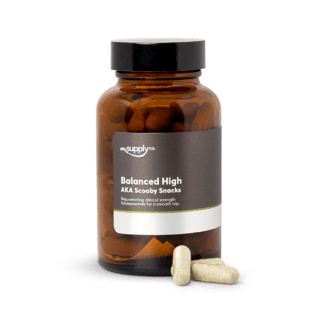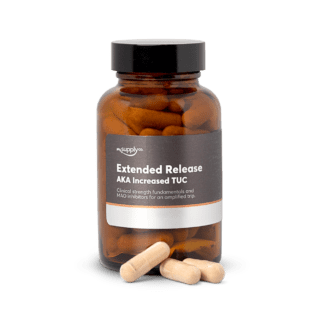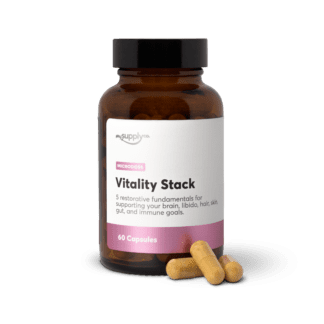Key takeaways.
-
Why is integration important?
Integrating a psychedelic journey is important so that its therapeutic potential can last for longer, and also to reconcile any confusing thoughts or feelings that arose during the experience itself.
-
What are the most important integration practices to use?
The best ones are spending time in nature, meditating, breath work, journalling, and talking to people you trust.
-
What are some integration practices to avoid?
Avoid making rash decisions in the days after your journey and don't go around telling everybody that they should use magic mushrooms or other psychedelics!
We recently shared with you an article on the importance of preparing for your magic mushroom experience. The lead-up plays a big role in what happens during the journey. But what happens after – the actual integration of the psychedelic experience – is equally important.
Timothy Leary says that the moment you start to “come back” to the physical world, you’ve begun “re-entry”. Re-entry doesn’t end after a good night’s sleep. Rather, the next few days can be spent achieving a smooth re-entry—if you know how to create the correct environment.
In all fairness, integration looks a lot like preparation, but there are a few extra tips we have for you for post-dose care. In order for the therapeutic, positive effects of your magic mushroom experience to be felt long after the journey itself, integration is absolutely vital.
Your magic mushroom experience might have a great impact.

It’s important to integrate your psychedelic journey because the journey itself can be one of the most impactful events of your life. Many LSD, ayahuasca, and magic mushroom users report that the experience is transformative, although scientists are still trying to understand this phenomenon.
These experiences can be especially transformative depending on the dosage, strain, and potency of the psilocybin mushrooms you consume. We recommend the Golden Teacher strain of the Psilocybe cubensis species for your mushroom trip, as it provides a potent psychedelic experience that is simultaneously gentle and balanced. Alternatively, our Balanced High macrodose capsules are a refined take on the Scooby Snacks formula, and our Brain Stack is trusted by our customers and the therapists we work with.
Experiences that have this great of an impact on our lives don’t come around very often. It’s like our wedding day, the death of a loved one, or the birth of a child. There are certain moments in life that seem to mean a great deal. And those events typically tend to carry that importance throughout the rest of your life.
So if magic mushrooms are like that (or can be like that), then preparation and integration are due.
Just like we don’t just get over the death of a loved one, we don’t just get over a mushroom journey. It can take time to integrate what you’ve seen, learned, and felt. You wouldn’t process the passing of a family member while you were at work; you’d probably take a few days off work for that. Even researchers have included post-drug integrative therapy sessions to support their study subjects.
Well, the principle is exactly the same with magic mushrooms or any other psychedelic experience. It’s impactful; it’s transformative; and you ought to take some time to process that experience. Here are some tips on how to do that.
A guide to psychedelic integration.
1. Have at least 2 days post-dose to chill.
Integration begins with time and space. That means time that you don’t have to work or attend commitments. Even family lunches or social events are considered too much work for post-psychedelic integration.
These couple of days should be spent at your leisure, doing any number of the activities we’re about to suggest to you.
Most importantly, you can’t do any proper integration while you’re busying yourself with meetings, work, emails or commitments. Take the time; at least 2 days.
2. Spend some time in nature.

While your brain and mind are in a very malleable, hypnagogic state, it can be very meditative to spend some time in the elements. Spending time in nature improves mental health in a number of ways, but the environment itself is also very conducive to meditation. And that’s something you should do a lot of while you’re “re-entering” the physical world.
While you’re spending time in nature, you might reconnect with some of the thoughts, feelings, or visions you had during your experience. It’s a chance to see those experiences from a “sober” perspective and begin integrating them into your daily life and behaviour.
3. Journal. Draw. Express.
You might find that in the days after your journey, you have a lot of emotions, memories, and abstract thoughts. Part of the integration process is to express those feelings and emotions. Plus, there’s a lot that you might have experienced that will soon begin to fade away, so journaling about your experience both during and after can help to solidify those experiences into your memory.
You might write about some of the memories you had, some of the people who popped up in your head, or some of the scary parts of the journey. It’s entirely up to you; journaling should feel free and natural.
Emily Williams, a San Francisco psychotherapist who specializes in post-psychedelic integration suggests a mandala art activity. It’s unguided and intuitive. You give yourself a set period of time and just start filling the page with mandala patterns.
4. Breathwork and meditation.
For some psychedelic users, meditation is the only way to stretch out the clarity and quietude that can come with a psychedelic experience. Plenty of people feel relaxed or “cleansed” and want to maintain that feeling for as long as possible. Meditating on that feeling or doing breathwork activities can help.
Breathwork and meditation are also useful in the event that the experience didn’t leave you feeling so relaxed or peaceful. Meditation and breathwork exercises can help you settle into your body so that you’re better able to process difficult experiences and transform them into healing ones.
5. Pay attention to your dreams.
You might also find that after your magic mushroom experience, your dreams are more vivid for a few days. It’s a good chance to check in with your dreams. Keep your “eyes” open for symbols and people that connect you with the psychedelic experience you had. They can be clues as to what kind of emotional processing is happening for you.
You can also keep a journal of your dreams alongside your daytime journal.
6. Talk to people you trust.
It can be an important time to share. With the many ideas and feelings that are coming to you, it pays to have people you trust around to offload onto. It’s important that those who you share your psychedelic journey with aren’t judgemental. They should be able to sit there and listen to all of your meanderings without calling you crazy!
It’s even better if they’re people that have also had a psychedelic experience before.
Things not to do during post-dose integration.

Just as there are do’s, there are some very clear don’ts. With all of the feelings and the sense that what you’ve gone through was the most epic thing of your life, it can be easy too carried away. So here are some post-dose practices we definitely don’t recommend.
Don’t try to convert everybody into a mushroom tripper.
Ahh, everybody has that friend. Trust us, you don’t want to be them. The person who sounds a little too much like an evangelical and after their journey, wants to go around telling everybody that they must get on the psychedelics.
Your feelings probably come from a good place. But people still don’t want to be told what to do. Plus, your experience with psychedelics might not be the same for them, and it’s not up to you whether or not others use psychedelic drugs.
Don’t tell everyone what your journey was like.
Keep a few things personal or between yourself and people you trust. You should treat your experience as if it’s a little dream and if you tell everybody about it, it’ll lose its power and won’t come true. And it is kind of like that.
The visions you receive of your deepest desires or your deepest fears are so delicate. When you talk to people about it, it’s very easy for them to plant a seed of doubt in your mind. And every time you repeat what happened, your experience loses a little bit of its magic.
Don’t make rash decisions to try and change your life.
It’s very normal to get the feeling that you have to change some things in your life after a magic mushroom or psychedelic journey. After you get insights into your bad habits or bad relationships there comes a sense of urgency to rectify those shortcomings. Of course it’s important to follow through with the guidance you receive — but don’t make rash decisions.
Before you go quitting your job or dumping your husband, take a few days to meditate on it and again, talk with people you trust.
Integration is the most important part of entheogenic practice.
Sometimes, the most profound parts of a magic mushroom experience happen after it’s done. A conversation you have with your lover; a moment you share with your book or a meditation on the beauty of a flower. For reasons we don’t understand, the healing effects of psychedelics go on long after the experience itself is over. And so you have to still treat yourself as if you’re in that healing process.
If the most you get out of your post-psychedelic integration is a couple of days of self-care, that’s also warranted. After a journey like that, a little self-care goes a long way.
What are some of your post-dose integration practices? We’d love to hear from you in the comments!
Read: How to Make Shroom Tea: The Ultimate Mushroom Tea Guide
Read: How to Make Magic Mushroom Brownies
Read: How to Lemon Tek Magic Mushrooms
Psychedelic integration FAQs.
-
What is the importance of post-dose integration following a magic mushroom experience?
Post-dose integration is essential because it helps you make the most of the transformative effects of a magic mushroom journey. These experiences can be highly impactful, and integrating them into your life is crucial for lasting benefits.
-
What are some post-dose integration practices?
We recommend several post-dose integration practices, including:
→ Taking at least two days of free time for reflection and processing.
→ Spending time in nature to meditate and reconnect with thoughts and feelings from the experience.
→ Expressing your thoughts and feelings through journaling or creative activities like mandala art.
→ Engaging in breathwork and meditation to maintain the calmness achieved during the experience.
→ Paying attention to your dreams, as they may provide insights into your emotional processing.
→ Sharing your experiences with trusted individuals who can listen without judgment. -
What should one do if they feel the need to make significant life changes after a magic mushroom journey?
It's common to feel the need for change after a transformative experience, but it's essential not to make rash decisions. Instead, take time to reflect on these feelings, meditate on them, and talk to people you trust for guidance and support before making any significant life changes.
-
Why is integrating a magic mushroom experience important, even after the experience itself is over?
Integrating a magic mushroom experience is essential because the healing and transformative effects of psychedelics can continue long after the journey is complete. The moments you share with loved ones, the insights gained, and the newfound clarity can be incredibly valuable, and treating yourself with care during the integration process is warranted.
-
How can breathwork and meditation help in post-dose integration?
Breathwork and meditation can help maintain the clarity and calmness that can result from a magic mushroom experience. They can also assist in processing difficult emotions and experiences by helping individuals settle into their bodies and transform challenging experiences into healing ones. Physiologically, they trigger the same neuroplasticity mechanisms as psilocybin, which improves functional brain connectivity in your brain.
-
Why is spending time in nature recommended as part of post-dose integration?
Spending time in nature is recommended because it has been shown to improve mental health and provides an environment conducive to meditation. This natural setting allows individuals to reconnect with thoughts and feelings from their psychedelic experience and integrate these insights into their daily lives.
-
Can the impact of a magic mushroom experience vary depending on factors like dosage and strain?
Yes, the impact of a magic mushroom experience can vary based on several factors, including the dosage, strain, and potency of the psilocybin mushrooms consumed. These factors can influence the depth and nature of the experience.
-
What is psychedelic therapy, and how does it help with post-dose integration?
Psychedelic therapy is a structured therapeutic approach that uses psychedelics like magic mushrooms in a clinical setting. It provides a safe and supportive environment for individuals to explore their inner experiences, which can be highly beneficial for post-dose integration. During therapy, individuals can gain insights, process emotions, and integrate their psychedelic experiences more effectively.
-
Is psychedelic therapy legal and accessible to everyone?
Psychedelic therapy is legal in Canada. However, the accessibility of psychedelic therapy varies depending on your medical concern and the specific substances used. As of this writing, Ketamine and, to an extent, psilocybin have been approved for psychedelic therapy in Canada. Access to these therapies is generally limited to qualified individuals, and participation often requires meeting specific criteria and regulations. We include in-depth resources and FAQs in our psychedelic-assisted therapy directory.
-
How does a typical psychedelic therapy session work to facilitate integration?
A typical psychedelic therapy session involves the administration of a psychedelic substance in a controlled environment, followed by structured support and guidance from trained therapists. During the session, individuals are encouraged to explore their thoughts, emotions, and experiences. Therapists help clients process and integrate insights gained during the session to facilitate personal growth and healing.
-
How long does the integration process typically take with the help of psychedelic therapy?
The duration of the integration process can vary from person to person. It depends on the individual's unique experiences, needs, and the specific therapeutic approach used. Some people may experience significant integration after just a few sessions, while others may require more extended treatment.
-
How can I find a reputable and qualified therapist or clinic for psychedelic therapy?
Browse our Trusted Psychedelic Therapists portal to find a reputable therapist that is well-versed in psychedelic-assisted therapy. We've ensured that they operate legally, have experienced and qualified therapists, and have a strong focus on safety and ethical practices. You can also seek recommendations from trusted sources and inquire about their credentials and the therapeutic approaches they use.
-
Is post-dose integration only important after a macrodose of psychedelics, or does it apply after a microdose as well?
Post-dose integration is important after both macrodoses and microdoses of psychedelics. While the depth and intensity of experiences differ between macrodoses (typical full doses) and microdoses (sub-threshold doses), both can have a significant impact on an individual's mental and emotional well-being. Integration helps individuals process insights, emotions, and changes in perspective that may arise from either type of dosing.
-
How does post-dose integration after microdosing differ from macrodosing?
The main difference in post-dose integration between microdosing and macrodosing is the intensity and duration of the experiences. Macrodoses tend to lead to profound, often more transformative experiences, which may require deeper processing and integration. Microdoses, while subtler, can still bring about changes in mood, creativity, and overall well-being that benefit from reflection and integration.
-
Are the integration techniques different for microdoses compared to macrodoses?
The integration techniques may vary depending on the individual and their experiences, but the fundamental principles remain the same. Techniques such as journaling, mindfulness, meditation, and discussions with trusted individuals can be used for both microdosing and macrodosing integration. The intensity and nature of experiences may influence the specific focus of integration, but the process is adaptable to each person's unique needs.
-
How frequently should I engage in post-dose integration after microdosing?
The frequency of post-dose integration after microdosing can vary based on personal preferences and experiences. Some individuals may choose to engage in regular reflection and integration exercises, while others may do so as needed or based on their specific goals. It's essential to find a rhythm that suits your individual needs and objectives.
-
Can microdosing without post-dose integration lead to long-term benefits?
Microdosing without post-dose integration can still lead to some short-term benefits, such as improved mood or creativity. However, to maximize the long-term benefits and make lasting changes in one's life, integrating the insights and experiences gained from microdosing is crucial. Post-dose integration helps individuals apply what they've learned to their daily lives and personal growth.
-
Are there resources or professionals who specialize in microdosing integration?
Yes, there are resources and professionals who specialize in microdosing integration. Some therapists and coaches offer services specifically tailored to microdosing experiences. Additionally, online communities and forums often provide valuable insights and techniques for those looking to integrate the benefits of microdosing into their lives.
Explore our psilocybin mushroom formulas.
-
 2856
2856
Balanced High | Macrodose Capsules
AKA Scooby Snacks, 250mg psilocybin per capsule
-
 3060
3060
Brain Stack | Microdose Capsules
Optimal Cognition + Brain Health
-
 3060
3060
Energy Stack | Microdose Capsules
Energy + Mood + Brain Function
-
 2856
2856
Extended Release | Macrodose Capsules
AKA Increased TUC, 250mg Psilocybe cubensis per capsule
-
 20% OFF
20% OFF
The Great Escape
Balanced High + Uplift
-
 3060
3060
Vitality Stack | Microdose Capsules
Age Backwards





